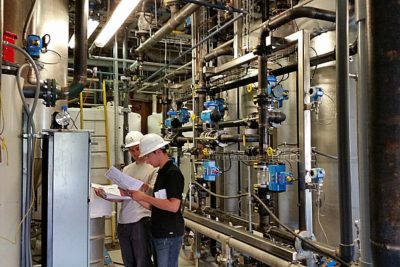Project highlights and product features
- Full-scale application designed to treat and reinject 80 to 100 gallons of groundwater per minute
- System treats a mixture of groundwater extracted from a series of plume control wells with highly variable concentrations of 1,4-dioxane, other chlorinated constituents and dissolved iron
- System was designed for remote monitoring and control for continuous operation with minimal operator oversight
- Installed in a tight footprint in an existing building that formerly housed an air stripper and carbon off-gas treatment system
- System has operated at 99% uptime since July 2014 with treated effluent non-detect (ND) at 0.04 parts per billion (ppb) for 1,4-dioxane and ND at 1 ppb for total volatile organic compounds (TVOC), well below Massachusetts permit limits
Groundwater treatment at former electronics production facility

ECT2 designed and installed a full-scale synthetic media system to treat 1,4-dioxane and volatile organic compounds (VOCs) from groundwater extracted as part of a long-term groundwater pump-and-treat remediation system at a former electronics production facility in Waltham, Mass. The system was designed to treat 80 to 100 gallons of groundwater per minute from wells located in and around residual contamination in the source area and extended plume.
Groundwater from a series of 12 recovery wells was pretreated to control iron residuals and reduce risk of recharge gallery fouling prior to removing VOCs and 1,4-dioxane. Synthetic media treatment was selected for this application because: (1) 1,4-dioxane was not amenable to the air stripping previously applied on this site; (2) past project experience with air stripping and infiltration gallery iron fouling added complexity and operating cost to the previous remedy; (3) the complexity and energy required for advanced oxidation would have been prohibitive; (4) advanced oxidation processes applied on other sites with similar contaminant profiles and geochemistry had proven ineffective for achieving consistent, stringent discharge control.
The synthetic media system uses of AMBERSORBTM 560 (AMBERSORB), a carbonaceous adsorbent produced by The Dow Chemical Company. ECT2 supported Dow during product development. The product’s hydrophobic nature and unique pore size distribution render it substantially more effective than activated carbon for adsorbing highly miscible compounds such as 1,4-dioxane. AMBERSORB has been used for decades as a specialized sorbent for multiple applications.
Consistent treatment performance and efficiency
The system’s design is based on the results of bench and pilot testing, which demonstrated the viability of the technology as a reliable treatment option. Water is pumped in an up-flow mode through media vessels containing AMBERSORB operated in series (e.g. a lead-lag-polish operation). When media capacity is exhausted, steam regeneration is performed in a down-flow mode that produces a steam condensate containing 1,4-dioxane and other chlorinated compounds. Vessels are regenerated one at a time, leaving the remaining vessels in service to maintain continuous groundwater extraction and consistent treatment efficiency.
The equipment has been operating with an uptime approaching 99% since startup in 2014. Influent 1,4-dioxane concentrations ranged from ND to 12 ppb, with an average of 5.9 ppb. Effluent concentrations since startup are reliably ND for 1,4-dioxane and TVOCs alike, with a four-to-five order of magnitude destruction removal efficiency.